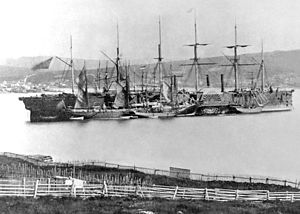
Figure 1 – The ship that lay the 1866 transatlantic cable, The Great Eastern, at Hearts Content. From the Wikicommons and in the public domain.
We talk about the internet as a new invention, something born of the twentieth and twenty-first centuries. However, if you think about it and the recognize that the essence of the the internet is not in the computer but is its role as a communications network, joining people on a world-wide web or net, the name of Samuel F. B. Morse (1791-1872), artist and daguerreotypist, immediately arises as the true inventor.
Samuel Morse, invented the telegraph and the Morse code. On May 24, 1844 along a cable strung between Washington, DC and Baltimore, MD, Morse sent the message: “WHAT HATH GOD WROUGHT.” The internet was born.
The dream of connecting the United States and Europe evolved between 1854 and 1866 with the laying of the first transatlantic cable by Cyrus West Field and the American Telegraph Company. On August 16, 1858, the first message was sent from the United States on behalf of President James Buchanan: “GLORY TO GOD IN THE HIGHEST; ON EARTH, PEACE AND GOODWILL TOWARD MEN.” The rate of transmission was painful (2 min. per character or 0.1 words per min.). Queen Victoria’s letter congratulations back to President Buchanan took sixteen hours to transmit.
The original cable deteriorated extremely rapidly. Speed of transmission became slower and slower. Three weeks after the first transmission engineer Widman Whithouse attempted to increase transmission speed by increasing the signal voltage and blow the cable out. Investor enthusiasm plummeted, and it took another eight years to successfully lay a new cable and restore the system. This new cable proved long-lasting and, perhaps of equal significance, in the intervening time overland cables had been laid in both Europe and the United States. Indeed the transcontinental cable in the United States, which united the east and west coasts on October 24, 1861, made the legendery Pony Express obsolete, and it shut down the next day. With the completion of the transatlantic cable, Europe and the United States were interconnected with what was truly the first internet.
The effect was transformative. Even with steam ships it took two to three weeks to transmit information by letter between New York and the European capitals. With the transatlantic cable this communications time was reduced to three minutes. That’s over ten thousand fold!
The first internet was the wired telegraph. This followed by wireless telegraphy, wired telephony, and radio. I leave television out, because television largely functioned one way. Finally we have our current internet, which took the concept to a whole new level by uniting computers or central processing units. The internet became more than a way of rapid communication, but became a place to store, access, and disseminate information (real, false, and imagined). We have spoken previously about the first image on the modern internet, the image of “Les Horribles Cernettes,”. But before that came the first transmission of images over telegraph and telephone lines. How this was done and indeed the underlying nature of transmitting this kind of information is a fascinating one that we we will take up next.

Pingback: The seduction of the nineteenth century | Hati and Skoll Gallery
Pingback: The closing of the the Indian telegraph – Ghandi’s internet | Hati and Skoll Gallery